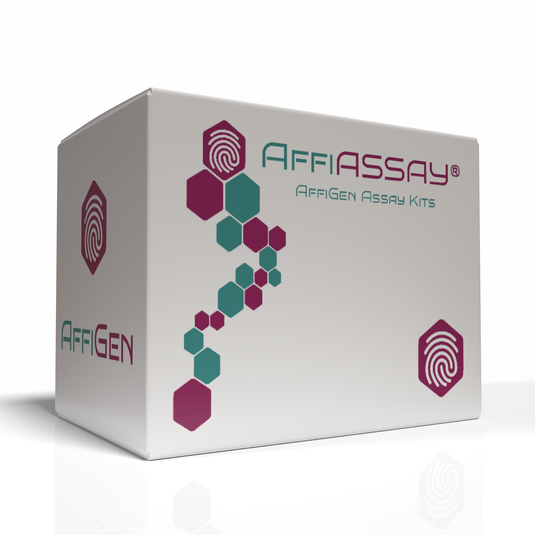AffiASSAY® ATP Colorimetric & Fluorometric Assay Kit
AffiASSAY® ATP Colorimetric & Fluorometric Assay Kit is designed to provide precise and reliable measurements of adenosine triphosphate (ATP) levels in biological samples. This assay kit offers both colorimetric and fluorometric detection methods, providing flexibility for researchers in the fields of biochemistry, molecular biology, and cell biology.
Key Features:
- High Sensitivity: Our assay kit is optimized to detect even low levels of ATP, allowing for accurate quantification in a wide range of samples.
- Colorimetric and Fluorometric Detection: Choose between colorimetric or fluorometric detection methods based on your experimental needs, ensuring robust and reproducible results.
- Wide Application: The AffiASSAY® ATP Colorimetric & Fluorometric Assay Kit can be used with various sample types, including cell lysates, tissue homogenates, serum, plasma, and culture supernatants.
- Quick and Easy: With a simple and streamlined protocol, you can obtain results in just a few easy steps, saving you valuable time in the lab.
- Versatile: Whether you're studying cellular energetics, evaluating ATP-dependent processes, or screening compounds that modulate ATP levels, our kit provides the versatility you need.
Assay Principle:
This assay kit employs both colorimetric and fluorometric methods based on the reaction between ATP and luciferin/luciferase enzyme system. In the presence of ATP, luciferase catalyzes the oxidation of luciferin, resulting in the emission of light. The light emission can be quantified either by measuring absorbance or fluorescence intensity, allowing for precise quantification of ATP levels.
Applications:
- Cellular Energetics: Measure ATP levels to assess cellular energy status and metabolic activity in various cell types and conditions.
- ATP-Dependent Processes: Study ATP-dependent processes such as protein synthesis, ion transport, and signal transduction in biological systems.
- Drug Screening: Screen compounds for their effects on ATP levels, aiding in drug discovery and development for various diseases.
Kit Contents:
- ATP Assay Buffer
- ATP Standard
- Luciferin/Luciferase Reaction Mix
- Stop Solution
- 96-Well Assay Plate
- Detailed Protocol
Why Choose AffiASSAY®?
Our commitment to excellence and scientific rigor makes AffiASSAY® the trusted choice of researchers worldwide. We strive to provide you with innovative tools that deliver precise results and accelerate your research efforts.
AffiASSAY® ATP Colorimetric & Fluorometric Assay Kit Protocol:
[Please note that this protocol is a general guideline, and you should always refer to the specific instructions provided in the kit manual for accurate and detailed information.]
Materials Needed:
- AffiASSAY® ATP Colorimetric & Fluorometric Assay Kit
- Biological samples containing ATP
- 96-well microplate
- Microplate reader capable of measuring absorbance at specific wavelengths (for colorimetric detection) and fluorescence intensity (for fluorometric detection)
- Pipettes and tips
- Microcentrifuge tubes
Protocol:
Sample Preparation:
- Prepare your biological samples containing ATP. These samples can be cell lysates, tissue homogenates, serum, plasma, or culture supernatants.
- Ensure that your samples are stored and handled according to your specific experimental requirements.
Standard Curve Preparation:
- Reconstitute the ATP Standard provided in the kit according to the kit's instructions.
- Create a series of standard dilutions using the reconstituted ATP standard to generate a standard curve. Typical concentrations may range from 0 to 100 µM.
Assay Plate Setup:
- Label the microplate wells according to your experimental design, including wells for your samples, standards, and controls.
- If using controls, prepare control samples without ATP to serve as background controls.
Sample and Standard Addition:
- Add 50-100 µL of your prepared samples and ATP standards to the appropriate wells on the microplate.
- Ensure that the final reaction volume in each well is consistent.
Assay Reaction:
- Prepare the assay reaction mix by combining the ATP Assay Buffer and Luciferin/Luciferase Reaction Mix from the kit as instructed.
- Add the assay reaction mix to each well of the microplate containing samples and standards.
Incubation:
- Incubate the microplate at room temperature or the appropriate temperature (as specified in the kit instructions) for a recommended time to allow the enzymatic reaction to occur.
Measurement:
- For Colorimetric Detection: Measure the absorbance of each well at a specific wavelength (provided by the kit) using a microplate reader.
- For Fluorometric Detection: Measure the fluorescence intensity of each well using a fluorescence microplate reader with appropriate excitation and emission wavelengths (provided by the kit).
Data Analysis:
- Generate a standard curve using the absorbance or fluorescence values obtained from the ATP standards.
- Calculate the ATP concentrations in your samples based on their respective absorbance or fluorescence readings and the standard curve.
Results Interpretation:
- Interpret and analyze your results according to your research objectives.
- Note any variations or trends in ATP levels among your samples.
Data Presentation:
- Prepare your data for presentation or publication, and include the appropriate statistical analysis if required.
Cleanup:
- Dispose of all waste materials, including used assay components, according to your laboratory's safety protocols.
- Always refer to the specific instructions provided with the AffiASSAY® ATP Colorimetric & Fluorometric Assay Kit for any kit-specific details or variations in the protocol.
- Additionally, ensure that you adhere to the best practices and safety guidelines in your laboratory while conducting the assay.

